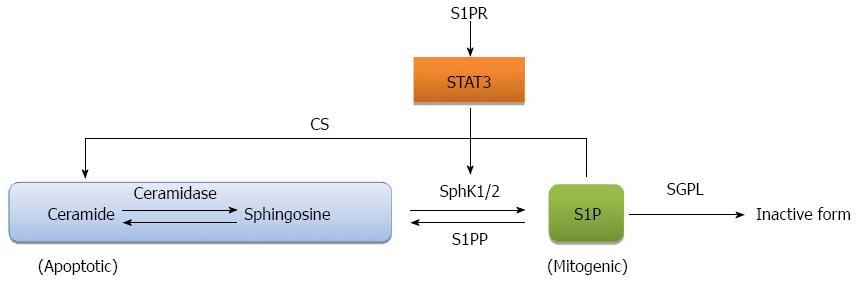Copyright
©2014 Baishideng Publishing Group Inc.
World J Gastroenterol. Aug 14, 2014; 20(30): 10279-10287
Published online Aug 14, 2014. doi: 10.3748/wjg.v20.i30.10279
Published online Aug 14, 2014. doi: 10.3748/wjg.v20.i30.10279
Figure 1 Hypothetical positive feedback pathway necessary for tumor progression.
In an inflamed region, pro inflammatory interleukin (IL)-6 produced by macrophages and other immune cells activated epithelial signal transducer and activator of transcription 3 via IL6R signaling. Signal transducer and activator of transcription 3 (STAT3) mediates cell proliferation and up regulation of S1PR’s. Signaling from S1PR maintains persistently activated STAT3 and up regulation of S1P kinases, which contributes to the overall increase in S1P pool. S1P auto-regulates epithelial cell growth and modifies immune cell recruitment including CD8+ T and Treg cells. S1P: Sphingosine-1-P.
Figure 2 Regulation of sphingosine 1 phosphate.
Ceramide and sphingosine 1 phosphate (S1P) are balanced by regulatory enzymes: sphingosine 1 phosphate kinases (SphK1 and 2), S1P phosphatase (S1PP), S1P lyases (SGPL) and ceramide synthase (CS). Activation of signal transducer and activator of transcription 3 (STAT3) from S1PR signaling shifts the balance toward more S1P production.
- Citation: Nguyen AV, Wu YY, Lin EY. STAT3 and sphingosine-1-phosphate in inflammation-associated colorectal cancer. World J Gastroenterol 2014; 20(30): 10279-10287
- URL: https://www.wjgnet.com/1007-9327/full/v20/i30/10279.htm
- DOI: https://dx.doi.org/10.3748/wjg.v20.i30.10279










